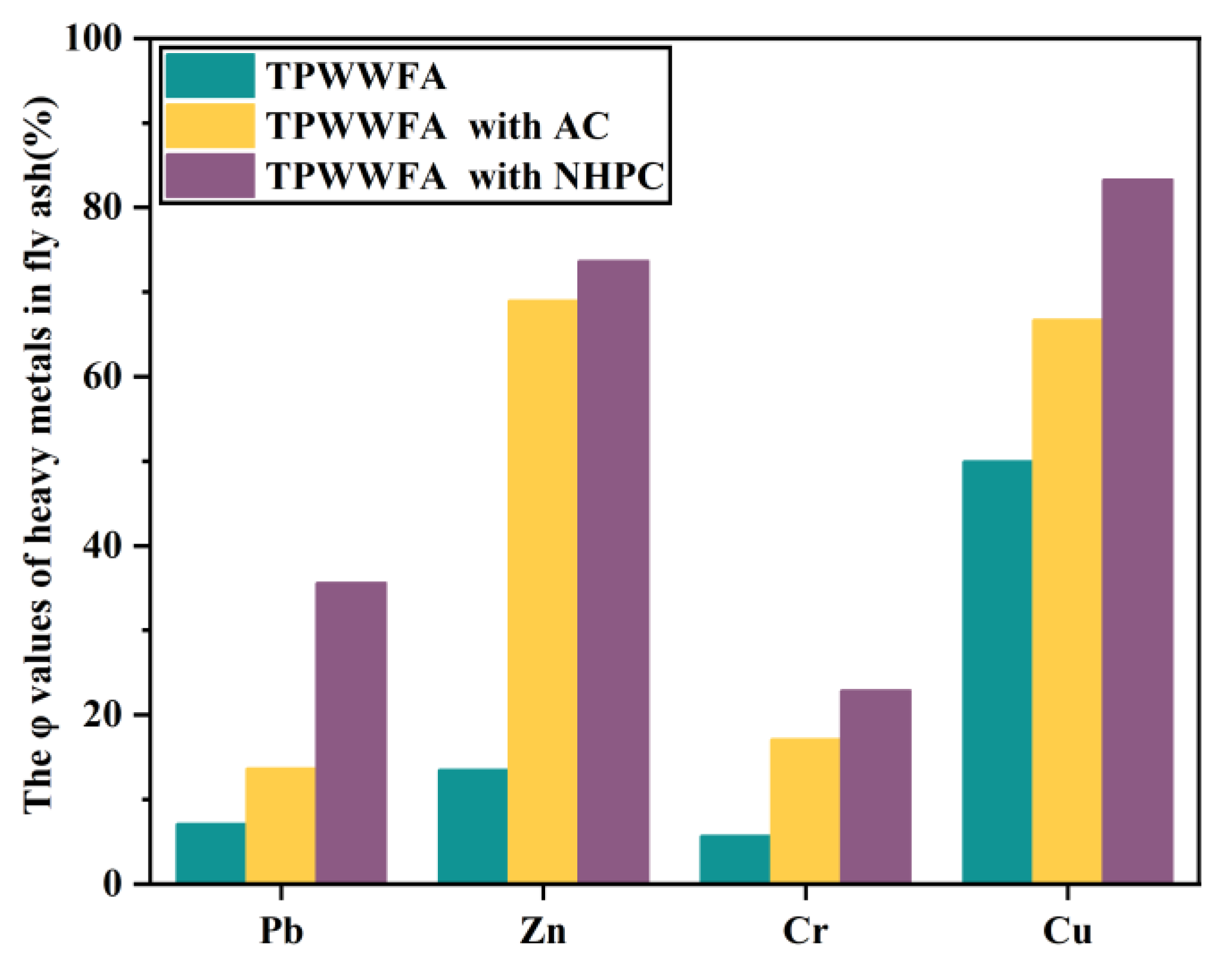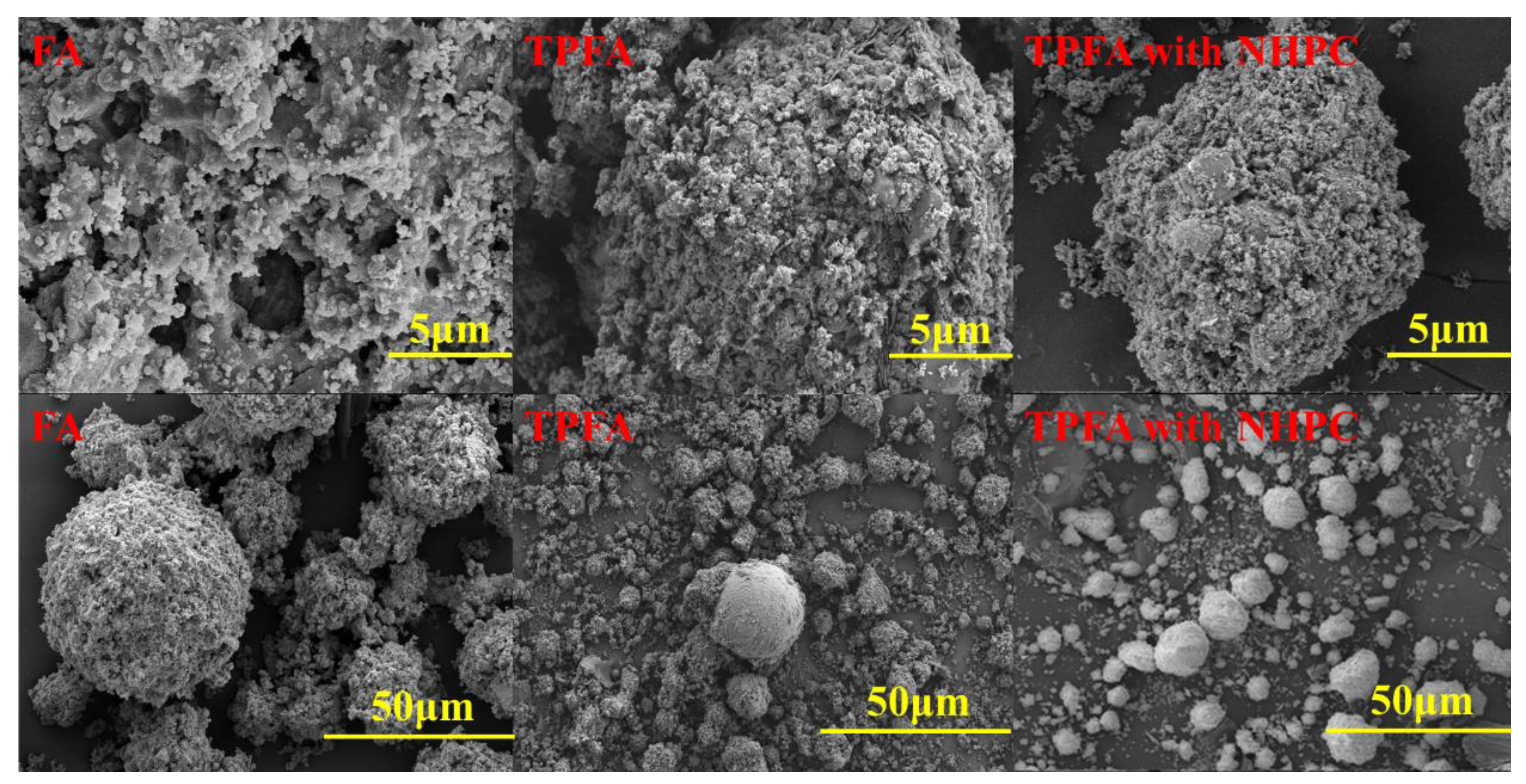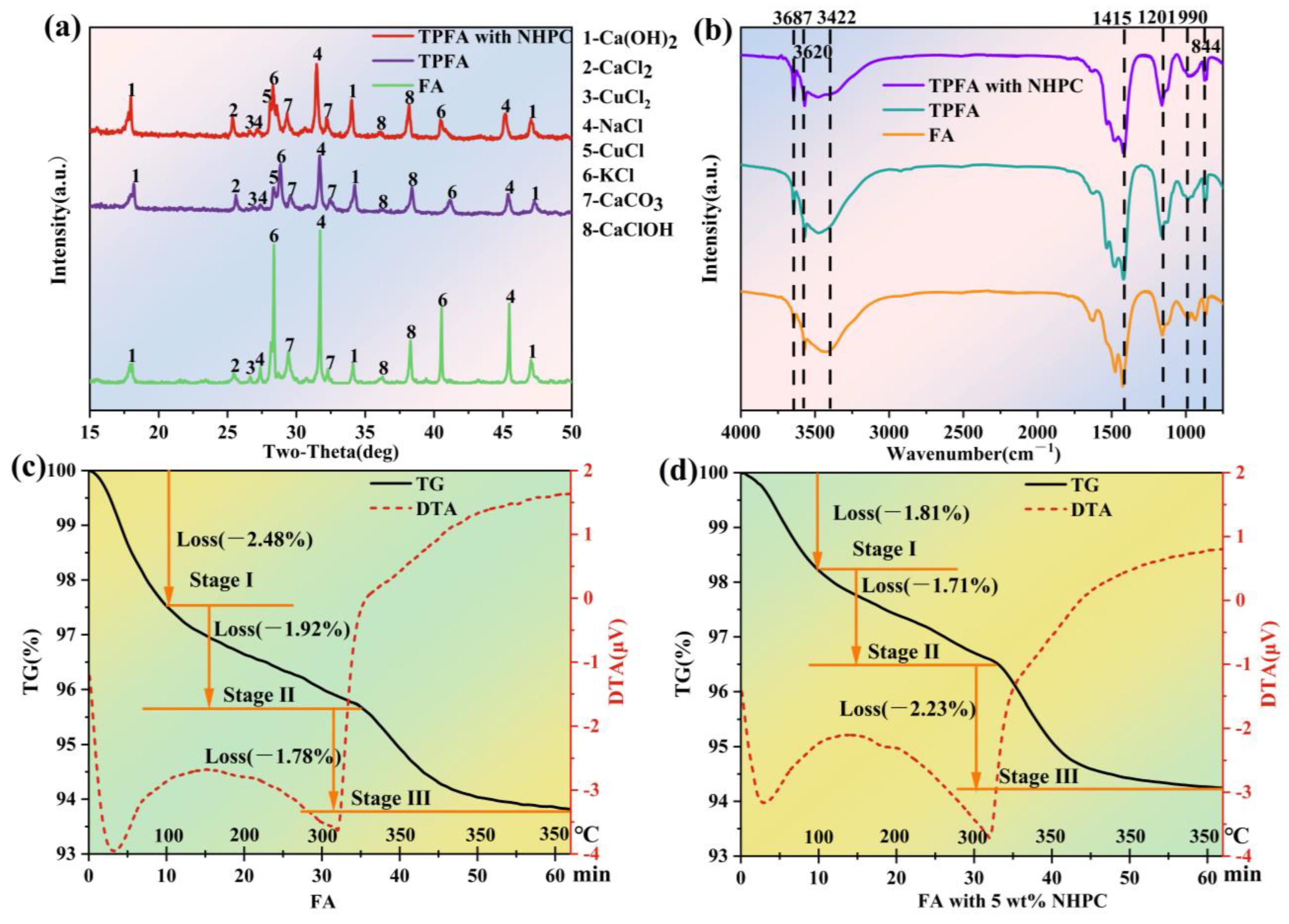Study on the Destruction of PCDD/Fs and Synergistic Solidification of Heavy Metals in Fly Ash by Low-Temperature Pyrolysis with the Assistant of N-Doped Hierarchical Porous Carbon
Abstract
Highlights
- The low-temperature destruction of PCDD/Fs during FA pyrolysis is enhanced by NHPC.
- More lower-chlorinated PCDD/Fs can be decomposed in the presence of NHPC.
- The heavy metals in fly ash are synergistically solidified with the aid of NHPC.
- NHPC regulates the structure properties and the chemical environment of fly ash.
- The addition of NHPC provides a novel research approach for the synergistic disposal of PCDD/Fs and heavy metals in fly ash.
Abstract
1. Introduction
2. Materials and Methods
2.1. Preparation of the Carbon Materials
2.2. The Water Washing Experiment
2.3. Low-Temperature Pyrolysis Experiment
2.4. Characterizations and Analysis
3. Results and Discussion
3.1. PCDD/Fs Destruction by Low-Temperature Pyrolysis
3.2. The Synergistic Solidification of Heavy Metals
3.3. The Characterizations of FA Samples
4. Conclusions
- (1)
- Enhanced dispersion and activation. NHPC can promote the uniform distribution and catalytic activity of alkali metal oxides on its surface.
- (2)
- Adsorption and contact enhancement. NHPC effectively capture PCDD/Fs and their precursors, increasing their interaction with alkali metal oxides.
- (3)
- Copper species modulation. NHPC facilitates the reduction of CuCl2 to CuCl, thereby passivating its catalytic role in PCDD/F formation.
- (4)
- Electron transfer facilitation. N-doping on the NHPC surface enhances the electron transfer between metal atoms and the carbon matrix, improving the catalytic activity of alkali metal oxides for PCDD/Fs decomposition.
- (5)
- Hydrodechlorination acceleration. The surface -NH and -NH2 groups imported by N doping can provide extra H protons, facilitating PCDD/Fs hydrodechlorination.
Supplementary Materials
Author Contributions
Funding
Data Availability Statement
Acknowledgments
Conflicts of Interest
References
- Chen, W.; Wang, F.; Li, Z.; Li, Q. A comprehensive evaluation of the treatment of lead in MSWI fly ash by the combined cement solidification and phosphate stabilization process. Waste Manag. 2020, 114, 107–114. [Google Scholar] [CrossRef] [PubMed]
- Li, W.; Yan, D.; Li, L.; Wen, Z.; Liu, M.; Lu, S.; Huang, Q. Review of thermal treatments for the degradation of dioxins in municipal solid waste incineration fly ash: Proposing a suitable method for large-scale processing. Sci. Total Environ. 2023, 875, 162565. [Google Scholar] [CrossRef] [PubMed]
- Deng, D.; Qiao, J.; Liu, M.; Kołodyńska, D.; Zhang, M.; Dionysiou, D.D.; Ju, Y.; Ma, J.; Chang, M.-b. Detoxification of municipal solid waste incinerator (MSWI) fly ash by single-mode microwave (MW) irradiation: Addition of urea on the degradation of Dioxin and mechanism. J. Hazard. Mater. 2019, 369, 279–289. [Google Scholar] [CrossRef]
- Xing, J.; Tang, Q.; Gan, M.; Ji, Z.; Fan, X.; Sun, Z.; Chen, X. Co-treatment of municipal solid waste incineration fly ash (MSWI FA) and municipal sludge: A innovative method to improve sludge dewatering with fly ash dechlorination. J. Environ. Manag. 2023, 332, 117403. [Google Scholar] [CrossRef] [PubMed]
- Li, J.; Lin, F.; Li, K.; Zheng, F.; Yan, B.; Che, L.; Tian, W.; Chen, G.; Yoshikawa, K. A critical review on energy recovery and non-hazardous disposal of oily sludge from petroleum industry by pyrolysis. J. Hazard. Mater. 2021, 406, 124706. [Google Scholar] [CrossRef]
- Zhang, J.; Zhang, S.; Liu, B. Degradation technologies and mechanisms of dioxins in municipal solid waste incineration fly ash: A review. J. Clean. Prod. 2020, 250, 119507. [Google Scholar] [CrossRef]
- Xue, Y.; Liu, X. Detoxification, solidification and recycling of municipal solid waste incineration fly ash: A review. Chem. Eng. J. 2021, 420, 130349. [Google Scholar] [CrossRef]
- Yan, J.; Yuan, W.; Liu, J.; Ye, W.; Lin, J.; Xie, J.; Huang, X.; Gao, S.; Xie, J.; Liu, S.; et al. An integrated process of chemical precipitation and sulfate reduction for treatment of flue gas desulphurization wastewater from coal-fired power plant. J. Clean. Prod. 2019, 228, 63–72. [Google Scholar] [CrossRef]
- Trinh, M.M.; Chang, M.B. Catalytic pyrolysis: New approach for destruction of POPs in MWIs fly ash. Chem. Eng. J. 2021, 405, 126718. [Google Scholar] [CrossRef]
- Trinh, M.M.; Chang, M.B. Transformation of mono- to octa- chlorinated dibenzo-p-dioxins and dibenzofurans in MWI fly ash during catalytic pyrolysis process. Chem. Eng. J. 2022, 427, 130907. [Google Scholar] [CrossRef]
- Fiorio, J.L.; Garcia, M.A.S.; Gothe, M.L.; Galvan, D.; Troise, P.C.; Conte-Junior, C.A.; Vidinha, P.; Camargo, P.H.C.; Rossi, L.M. Recent advances in the use of nitrogen-doped carbon materials for the design of noble metal catalysts. Coord. Chem. Rev. 2023, 481, 215053. [Google Scholar] [CrossRef]
- Yan, B.; Zheng, J.; Feng, L.; Zhang, Q.; Zhang, C.; Ding, Y.; Han, J.; Jiang, S.; He, S. Pore engineering: Structure-capacitance correlations for biomass-derived porous carbon materials. Mater. Des. 2023, 229, 111904. [Google Scholar] [CrossRef]
- Tang, M.; Huang, X.; Peng, Y.; Lu, S. Hierarchical porous carbon as a highly efficient adsorbent for toluene and benzene. Fuel 2020, 270, 117478. [Google Scholar] [CrossRef]
- Lu, S.; Huang, X.; Tang, M.; Peng, Y.; Wang, S.; Makwarimba, C.P. Synthesis of N-doped hierarchical porous carbon with excellent toluene adsorption properties and its activation mechanism. Environ. Pollut. 2021, 284, 117113. [Google Scholar] [CrossRef]
- Qiu, Q.; Chen, Q.; Jiang, X.; Lv, G.; Chen, Z.; Lu, S.; Ni, M.; Yan, J.; Lin, X.; Song, H.; et al. Improving microwave-assisted hydrothermal degradation of PCDD/Fs in fly ash with added Na2HPO4 and water-washing pretreatment. Chemosphere 2019, 220, 1118–1125. [Google Scholar] [CrossRef]
- Xue, Y.; Yang, T.; Liu, X.; Cao, Z.; Gu, J.; Wang, Y. Enabling efficient and economical degradation of PCDD/Fs in MSWIFA via catalysis and dechlorination effect of EMR in synergistic thermal treatment. Chemosphere 2023, 342, 140164. [Google Scholar] [CrossRef]
- Xiao, H.; Cheng, Q.; Liu, M.; Li, L.; Ru, Y.; Yan, D. Industrial disposal processes for treatment of polychlorinated dibenzo-p-dioxins and dibenzofurans in municipal solid waste incineration fly ash. Chemosphere 2020, 243, 125351. [Google Scholar] [CrossRef] [PubMed]
- Altarawneh, M.; Saeed, A.; Al-Harahsheh, M.; Dlugogorski, B.Z. Thermal decomposition of brominated flame retardants (BFRs): Products and mechanisms. Prog. Energy Combust. Sci. 2019, 70, 212–259. [Google Scholar] [CrossRef]
- Gao, C.; Yue, Y.; Li, W.; Zhang, Q.; Zhang, L.; Qian, G. Dual Positive Effects of Pre-Dechlorine and Low-Temperature Deep Reduction-Keeping on the PCDD/F Removal of Incineration Fly Ash. ACS EST Eng. 2024, 4, 2274–2283. [Google Scholar] [CrossRef]
- Grabias-Blicharz, E.; Franus, W. A critical review on mechanochemical processing of fly ash and fly ash-derived materials. Sci. Total Environ. 2023, 860, 160529. [Google Scholar] [CrossRef]
- Yan, D.; Peng, Z.; Yu, L.; Sun, Y.; Yong, R.; Helge Karstensen, K. Characterization of heavy metals and PCDD/Fs from water-washing pretreatment and a cement kiln co-processing municipal solid waste incinerator fly ash. Waste Manag. 2018, 76, 106–116. [Google Scholar] [CrossRef] [PubMed]
- Xu, T.; Wang, L.; Zeng, Y.; Zhao, X.; Wang, L.; Zhan, X.; Li, T.; Yang, L. Characterization of typical heavy metals in pyrolysis MSWI fly ash. Environ. Technol. 2018, 40, 3502–3511. [Google Scholar] [CrossRef]
- Zhao, C.; Zhao, Y.; Lin, K.; Wang, Z.; Zhou, T. Comprehensive assessment of thermal characteristics, kinetics and environmental impacts of municipal solid waste incineration fly ash during thermal treatment. Process Saf. Environ. Prot. 2023, 175, 619–631. [Google Scholar] [CrossRef]
- Gu, Q.; Wu, W.; Jin, B. Investigation of thermal characteristics of municipal solid waste incineration fly ash under various atmospheres: A TG-FTIR study. Thermochim. Acta 2019, 681, 178402. [Google Scholar] [CrossRef]
- Jamalimoghadam, M.; Vakili, A.H.; Keskin, I.; Totonchi, A.; Bahmyari, H. Solidification and utilization of municipal solid waste incineration ashes: Advancements in alkali-activated materials and stabilization techniques, a review. J. Environ. Manag. 2024, 367, 122014. [Google Scholar] [CrossRef] [PubMed]
- Sun, P.; Chen, S.; Xie, M.; Cheng, L.; Wang, J.; Dong, F.; Dong, X.; Weng, X. H-zeolite supported multi-interface metal catalysts for the catalytic destruction of chlorinated organics. Chem. Eng. J. 2025, 503, 158510. [Google Scholar] [CrossRef]
- Ndayiragije, S.; Zhang, Y.; Zhou, Y.; Song, Z.; Wang, N.; Majima, T.; Zhu, L. Mechanochemically tailoring oxygen vacancies of MnO2 for efficient degradation of tetrabromobisphenol A with peroxymonosulfate. Appl. Catal. B Environ. 2022, 307, 121168. [Google Scholar] [CrossRef]
- Zhao, S.; Muhammad, F.; Yu, L.; Xia, M.; Huang, X.; Jiao, B.; Lu, N.; Li, D. Solidification/stabilization of municipal solid waste incineration fly ash using uncalcined coal gangue–based alkali-activated cementitious materials. Environ. Sci. Pollut. Res. 2019, 26, 25609–25620. [Google Scholar] [CrossRef]
- Yuan, J.; Wen, Y.; Dionysiou, D.D.; Sharma, V.K.; Ma, X. Biochar as a novel carbon-negative electron source and mediator: Electron exchange capacity (EEC) and environmentally persistent free radicals (EPFRs): A review. Chem. Eng. J. 2022, 429, 132313. [Google Scholar] [CrossRef]
- Minnu, S.N.; Bahurudeen, A.; Athira, G. Comparison of sugarcane bagasse ash with fly ash and slag: An approach towards industrial acceptance of sugar industry waste in cleaner production of cement. J. Clean. Prod. 2021, 285, 124836. [Google Scholar] [CrossRef]
- Liu, J.; Doh, J.-H.; Dinh, H.L.; Ong, D.E.L.; Zi, G.; You, I. Effect of Si/Al molar ratio on the strength behavior of geopolymer derived from various industrial waste: A current state of the art review. Constr. Build. Mater. 2022, 329, 127134. [Google Scholar] [CrossRef]
- Lin, X.; Mao, T.; Chen, Z.; Chen, J.; Zhang, S.; Li, X.; Yan, J. Thermal cotreatment of municipal solid waste incineration fly ash with sewage sludge: Phases transformation, kinetics and fusion characteristics, and heavy metals solidification. J. Clean. Prod. 2021, 317, 128429. [Google Scholar] [CrossRef]
- Huang, B.; Gan, M.; Ji, Z.; Fan, X.; Zhang, D.; Chen, X.; Sun, Z.; Huang, X.; Fan, Y. Recent progress on the thermal treatment and resource utilization technologies of municipal waste incineration fly ash: A review. Process Saf. Environ. Prot. 2022, 159, 547–565. [Google Scholar] [CrossRef]
- Zhao, C.; Lin, S.; Zhao, Y.; Lin, K.; Tian, L.; Xie, M.; Zhou, T. Comprehensive understanding the transition behaviors and mechanisms of chlorine and metal ions in municipal solid waste incineration fly ash during thermal treatment. Sci. Total Environ. 2022, 807, 150731. [Google Scholar] [CrossRef]
- Wang, X.; Ji, G.; Zhu, K.; Li, C.; Zhang, Y.; Li, A. Integrated thermal behavior and compounds transition mechanism of municipal solid waste incineration fly ash during thermal treatment process. Chemosphere 2021, 264, 128406. [Google Scholar] [CrossRef]
- Wons, W.; Rzepa, K.; Reben, M.; Murzyn, P. Thermal studies of fly ashes expansion. J. Therm. Anal. Calorim. 2020, 143, 2883–2891. [Google Scholar] [CrossRef]
- Li, J.; Jia, A.; Hou, X.; Wang, X.; Mao, Y.; Wang, W. Thermal co-treatment of aluminum dross and municipal solid waste incineration fly ash: Mineral transformation, crusting prevention, detoxification, and low-carbon cementitious material preparation. J. Environ. Manag. 2023, 329, 117090. [Google Scholar] [CrossRef]
- Yuan, Z.; Xu, Q.; Chen, X.; Kong, L.; Li, K.; Wu, C.; Bai, J.; Guo, J.; Guo, Z.; Bai, Z.; et al. Immobilization of heavy metals with chlorine and liquid phase formation during thermal treatment of MSWI fly ash. Fuel 2024, 378, 132949. [Google Scholar] [CrossRef]
- Janković, M.; Janković, B.; Marinović-Cincović, M.; Porobić, S.; Nikolić, J.K.; Sarap, N. Experimental study of low-rank coals using simultaneous thermal analysis (TG–DTA) techniques under air conditions and radiation level characterization. J. Therm. Anal. Calorim. 2020, 142, 547–564. [Google Scholar] [CrossRef]
- Wang, J.; Zhang, Y.; Cui, K.; Fu, T.; Gao, J.; Hussain, S.; AlGarni, T.S. Pyrometallurgical recovery of zinc and valuable metals from electric arc furnace dust—A review. J. Clean. Prod. 2021, 298, 126788. [Google Scholar] [CrossRef]
- Hakeem, I.G.; Halder, P.; Patel, S.; Selezneva, E.; Rathnayake, N.; Marzbali, M.H.; Veluswamy, G.; Sharma, A.; Kundu, S.; Surapaneni, A.; et al. Current understanding on the transformation and fate of per- and polyfluoroalkyl substances before, during, and after thermal treatment of biosolids. Chem. Eng. J. 2024, 493, 152537. [Google Scholar] [CrossRef]
- Chen, W.; Gong, M.; Li, K.; Xia, M.; Chen, Z.; Xiao, H.; Fang, Y.; Chen, Y.; Yang, H.; Chen, H. Insight into KOH activation mechanism during biomass pyrolysis: Chemical reactions between O-containing groups and KOH. Appl. Energy 2020, 278, 115730. [Google Scholar] [CrossRef]
- Wang, X.; Lv, J.; Ying, Y.; Ma, Y.; Wu, A.; Lin, X.; Cao, A.; Li, X.; Yan, J. A new insight into the CaO-induced inhibition pathways on PCDD/F formation: Metal passivation, dechlorination and hydroxide substitution. Sci. Total Environ. 2023, 885, 163782. [Google Scholar] [CrossRef]





| Samples | Water Washing Pretreatment | Additives | Pyrolysis Temperature |
|---|---|---|---|
| FA | / | / | / |
| TPFA | / | / | 300 or 350 °C |
| TPFA with AC | / | 5 wt.% AC | 300 or 350 °C |
| TPFA with NHPC | / | 5 wt.% NHPC | 300 or 350 °C |
| WWFA | DI water: FA = 5 mL:1 g | / | / |
| TPWWFA | DI water: FA = 5 mL:1 g | / | 350 °C |
| TPWWFA with AC | DI water: FA = 5 mL:1 g | 5 wt.% AC | 350 °C |
| TPWWFA with NHPC | DI water: FA = 5 mL:1 g | 5 wt.% NHPC | 300 or 350 °C |
| Samples | SBET (m2/g) | Pore Volume (cm3/g) | Pore Size (nm) |
|---|---|---|---|
| FA | 13.0 | 0.065 | 9.6 |
| TPFA | 17.2 | 0.070 | 7.9 |
| TPFA with NHPC | 90.7 | 0.087 | 4.7 |
Disclaimer/Publisher’s Note: The statements, opinions and data contained in all publications are solely those of the individual author(s) and contributor(s) and not of MDPI and/or the editor(s). MDPI and/or the editor(s) disclaim responsibility for any injury to people or property resulting from any ideas, methods, instructions or products referred to in the content. |
© 2025 by the authors. Licensee MDPI, Basel, Switzerland. This article is an open access article distributed under the terms and conditions of the Creative Commons Attribution (CC BY) license (https://creativecommons.org/licenses/by/4.0/).
Share and Cite
Yue, M.; Wang, Q.; Wang, H.; Wang, X.; Jin, J.; Liu, D. Study on the Destruction of PCDD/Fs and Synergistic Solidification of Heavy Metals in Fly Ash by Low-Temperature Pyrolysis with the Assistant of N-Doped Hierarchical Porous Carbon. Processes 2025, 13, 1202. https://doi.org/10.3390/pr13041202
Yue M, Wang Q, Wang H, Wang X, Jin J, Liu D. Study on the Destruction of PCDD/Fs and Synergistic Solidification of Heavy Metals in Fly Ash by Low-Temperature Pyrolysis with the Assistant of N-Doped Hierarchical Porous Carbon. Processes. 2025; 13(4):1202. https://doi.org/10.3390/pr13041202
Chicago/Turabian StyleYue, Mingqi, Qiulin Wang, Haonan Wang, Xiaoyiran Wang, Jing Jin, and Dunyu Liu. 2025. "Study on the Destruction of PCDD/Fs and Synergistic Solidification of Heavy Metals in Fly Ash by Low-Temperature Pyrolysis with the Assistant of N-Doped Hierarchical Porous Carbon" Processes 13, no. 4: 1202. https://doi.org/10.3390/pr13041202
APA StyleYue, M., Wang, Q., Wang, H., Wang, X., Jin, J., & Liu, D. (2025). Study on the Destruction of PCDD/Fs and Synergistic Solidification of Heavy Metals in Fly Ash by Low-Temperature Pyrolysis with the Assistant of N-Doped Hierarchical Porous Carbon. Processes, 13(4), 1202. https://doi.org/10.3390/pr13041202






